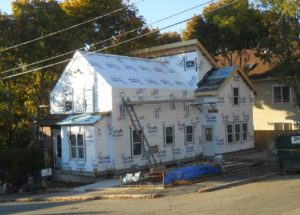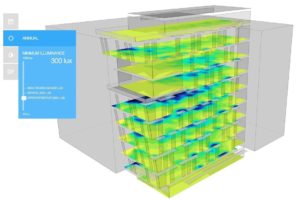This section addresses the many definitions of and new vocabulary associated with zero energy; it offers tools available for use by various stakeholders in a zero energy project; and it links to webinars presented by industry experts eager to share their knowledge of zero energy.
Today, zero energy buildings are a rapidly growing trend and are no longer solely demonstration projects and market outliers. Today’s portfolio of zero energy buildings includes a wide range of mainstream building and ownership types. While the technology is readily available, market adoption of zero energy is just beginning. As the concept and understanding of a zero energy building or district spreads, the vocabulary is evolving to better communicate these ideas. Many different metrics are available to measure and compare energy performance. In zero energy projects, there is often one leader who drives the low-energy design. Communicating and encouraging these ideas with other stakeholders and the design team is critical. Zero energy requires an ambitious community of the frontrunners in low-energy design to drive the industry and educate others.
DEFINITIONS
Building America Building Science Translator
The purpose of this document is to introduce a new set of vocabulary to better communicate and reinforce the value of high-performance homes. This vocabulary emphasizes improved consumer experience rather than engineering function.
A Common Definition for Zero Energy Buildings
Federal government agencies and many state and local governments are beginning to move toward targets for zero energy buildings (ZEBs). However, definitions differ from region to region and from organization to organization, leading to confusion and uncertainty around what constitutes a ZEB. This paper establishes definitions, associated nomenclature and measurement guidelines for ZEBs, specifically in commercial/industrial/institutional buildings, with the goal of achieving widespread adoption and use by the building industry.
Definition of Zero Net Energy (ZNE) for California State Agency Compliance with Executive Order B-18-12
With the issuance of Executive Order B-18-12, mandating zero net energy (ZNE) for new and existing state buildings, it has become necessary for the state of California to determine how it will define ZNE for compliance with state targets, and what strategies or prioritization it will encourage. A focus group of 20 energy professionals representing state agencies, utilities, federal and private sectors, recommended the acceptance of one definition, which was accepted by the governor’s office as the primary definition for use by state agencies in achieving and reporting on ZNE status for new and existing state buildings, and to be consistent with the federally adopted definition.
DOE Releases Common Definition of Zero Energy Buildings, Campuses and Communities
This article describes the U.S. Department of Energy’s (DOE’s) release of a common definition of a zero energy building. After leading an extensive stakeholder engagement process over the past year and a half, the DOE released its findings in the recently published A Common Definition of Zero Energy Buildings. The definition applies to buildings, campuses, portfolios, and communities. In addition to providing clarity across the industry, this new DOE publication provides important guidelines for measurement and implementation, specifically explaining how to utilize this definition for building projects.
ZNE Definitions & Key Considerations
Examples of zero energy buildings are increasing in number and building types around the globe. California is leading the way with aggressive goals of achieving zero net energy for all new residential by 2020 and for all new commercial by 2030. To understand the zero net energy landscape, policymakers, advocates and others should consider the variety of terms, acronyms and descriptions circulating among stakeholders and understand how these distinctions impact policy, program and design decisions.
TOOLKITS
 Communications Toolkit
Communications Toolkit
The conversation around zero net energy buildings is evolving with many different terms emerging to describe these recent developments. To support consistent and clear communications, New Buildings Institute (NBI) has developed a number of factsheets that early adopters and advocates can use to support information sharing on zero net energy. These toolkit items were developed by NBI and Resource Media and represent the foundational pieces of the ZNE Communications Toolkit.
Zero Tool
Architecture 2030 developed the Zero Tool for building sector professionals, 2030 Challenge and 2030 Commitment adopters, 2030 District Network Members, and policymakers. The Zero Tool is used to compare a building’s design or an existing building’s fossil fuel energy use intensity (FF-EUI) with similar building types, understand how a building achieved its FF-EUI (via energy efficiency, on-site renewable energy, and/or green power purchases), and set FF-EUI targets. A Zero Score allows properties and building codes to be compared based on their relative ‘percent from zero’, allowing for normalized property and code comparisons across diverse locations, space use types, and building characteristics.
WEBINARS
Deep Energy Retrofit: Vision, Goals and Process
Learn how to drive 30% or greater energy savings with National Grid and NBI. In part one of this three-part series, learn how deep energy retrofit projects maximize efficiency and energy savings, how to identify opportunities for deep energy retrofits both within a particular project and in groups of buildings, steps required to assess building conditions in order to support a deep energy retrofit, and how to assess different deep energy retrofit strategies for a project.
Deep Energy Retrofit: Best Practices in Technologies and Strategies
Learn how to drive 30% or greater energy savings with National Grid and NBI. In part two of this three-part series, you will understand the relationship between deep energy retrofits and code requirements, understand opportunities to use deep energy retrofits to make non-energy improvements to buildings, be able to align deep retrofit strategies with building strengths and weaknesses, and be able to identify pitfalls to pursuing deep energy retrofit technologies and strategies.
Deep Energy Retrofit: Getting to Zero Net Energy Capable
Learn how to drive 30% or greater energy savings with National Grid and NBI. In part three of this three-part series, you will understand the relationship between deep energy retrofits and zero energy, how to identify good and bad candidates for zero energy retrofits, how to integrate retrofits to maximize savings, and the role of operations in zero energy and how to support zero energy operations.
Driving High Performance: Role of Codes & Permitting in Zero Net Energy
Recent federal and state legislation is shaping how codes and permitting push regulations and policies for zero energy (ZE) buildings. This webinar dives into the role of codes and permitting in reaching ZE building goals. Learn how local jurisdictions are getting ahead of upcoming ZE mandates in California and how end users are taking advantage of streamlined permitting and reach codes to drive high performance.
Planning for Districts and Urban Environments
Campuses and districts are a growing trend in the zero energy marketplace. This webinar will examine the opportunities offered by large-scale developments including real-world examples from projects in Pittsburgh and Denver. Challenges presented by dense, urban environments will be spotlighted with analysis and recommendations for siting renewables or, in cases of limited rooftop space, prioritizing off-site renewable energy options for achieving zero energy.
Risks and Rewards in the ZNE Marketplace
What value is derived to owners and developers from a zero energy building? This webinar will explore and understand the developer and owner perspectives on investor value of zero and take a close look at income, cost, and risk. Panelists will present and discuss specific projects from a financial and business perspective, including design/construction targets and actual outcomes.
Strategies for Getting to Zero
Building design teams often start with two key parts to get to zero: passive design strategies and the availability for the production of site renewables energy (often called the solar budget). These speakers will use projects to demonstrate how they drill down into the energy targets, modeling, envelope and daylighting to reduce loads and assess and integrate the available renewables.
Zero Net Energy Building Trends and ZEDX Presentations
New Buildings Institute (NBI) recently completed its annual list of zero energy verified and emerging buildings and hosted a free webinar to share the trends identified through study of these model projects. NBI Research Director Cathy Higgins joins several industry experts spotlighting their experiences in zero energy.
ZNE Policies Within and Across Borders
The adoption of zero energy policies is extending across regions, countries, and through government. This session highlights the adoption reasons, efforts and planned impacts from European, Pacific Coast, Army and GSA zero energy policies and action plans.
ZNE & The School Community for Administrators and Stakeholders
This webinar is part of an investor-owned utility (IOU) pilot program aimed at leveraging California Proposition 39 dollars to test how some of the state’s existing K-12 and community college buildings can be transformed into zero energy facilities.
